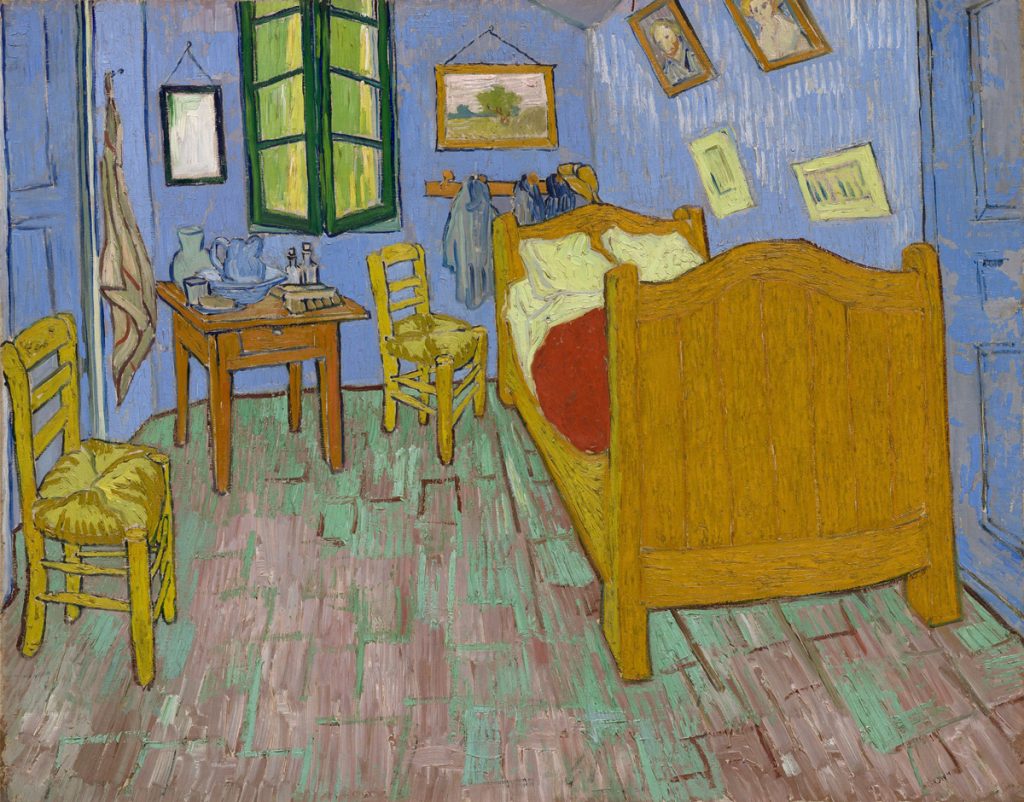A friendship Vincent Van Gogh formed in his final years is the cornerstone of a new MFA show.
by Bruce Sylvester / Troubadour, Thursdays 2 – 4 pm

The Bedroom, oil on canvas, by Vincent Van Gogh, 1889. The Art Institute of Chicago, Helen Birch Bartlett Memorial Collection
Wild slashes of brush strokes and vibrant color marked some Vincent Van Gogh paintings, though there were other sides to his work too. In 1888 the emotionally troubled Dutch artist left the artistic hotbed Paris to move to the relative calm of Arles in southern France. After months of social isolation, he made friends with a postman, Joseph Roulin, in a cafe and went on to do a series of 26 portraits of him, his wife and three children.
Thirteen of them are the cornerstone of a new show at the Museum of Fine Arts, Van Gogh: The Roulin Family Portraits, where we glimpse bits of his daily world in the two years leading up to his suicide at age 37 in 1890.
As the MFA tells us, “We don’t know why Van Gogh decided to move to this particular town in Provence, but the slower pace of life and lower cost of living in southern France were likely appealing, as were the brighter sunlight and warmer weather.” The yellow house where he lived and worked was destroyed by World War II bombing, but we see his painting of it along with pictures of his bedroom and chair.
We enter the show to the music of Berlioz, which he called art for disturbed hearts. Then we meet monsieur Roulin, resplendent in his postal uniform and exuding pride over the birth of his third child, his first daughter, earlier in the day he sat for the portrait.
The next room shows us the three children, each alone. Looking straight ahead we can savor a strategically placed portrait of madame Augustine Roulin. The unseen end of a cord in one rendition of her upper body and face was in reality tied to a cradle for rocking baby Marcelle. Multiple paintings of a single working class family were unusual for the period. Such portraiture was usuallyfor nobles and the wealthy.
The context of the show is enhanced by photos of various Moulins in later years. Father Joseph’s distinctive appearance remains the same over time. Marcelle became one of the last people alive who had been around Van Gogh. An informal photo from her senior years shows her standing with her portrait.
He took artistic liberties with settings in the portraits: sometimes bold-hued solid blocks, sometimes floral patterns in the background, sometimes both. Do the colors and style reflect the mood and vibe of southern France? Certainly more than they would the Paris he left behind. A self-portrait done in Arles suggests a more peaceful state of mind than one done during his Paris days. But that was not the case. We see 10 letters with accompanying translations from Joseph Roulin to Van Gogh and his brother Theo concerning his mental state and institutionalization. It was in Arles that he cut off an ear.
Along with the Roulin pictures, there are natural scenes (one quite arresting) and religious works. Remember, Vincent had previously attempted a career as a minister. As with the recent Salvador Dali show at the MFA, we get added context with the inclusion of a few pieces by earlier artists such as a religious Rembrandt that could well have influenced Van Gogh. The Dali exhibit did this more effectively, perhaps because it was easier to do with Dali.
With 14 of the original 26 Roulin portraits, the show at its core is about a friendship that Van Gogh surely needed given his mental and financial states.
Van Gogh: The Roulin Family Portraits is at the Museum of Fine Arts through September 7. Admission tickets are for timed entry.
